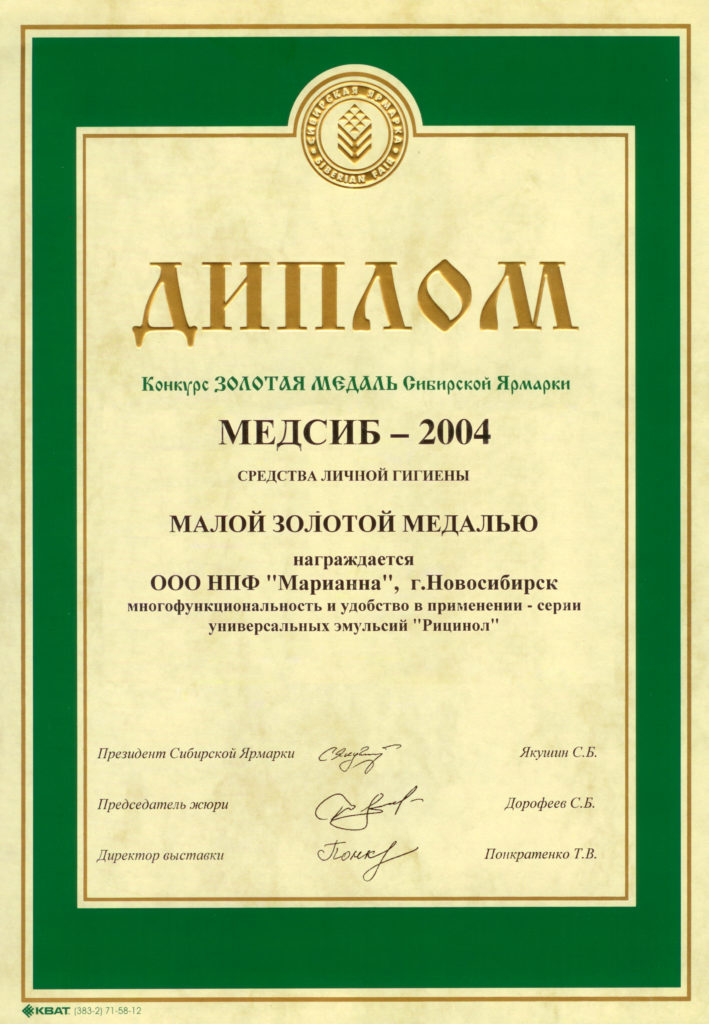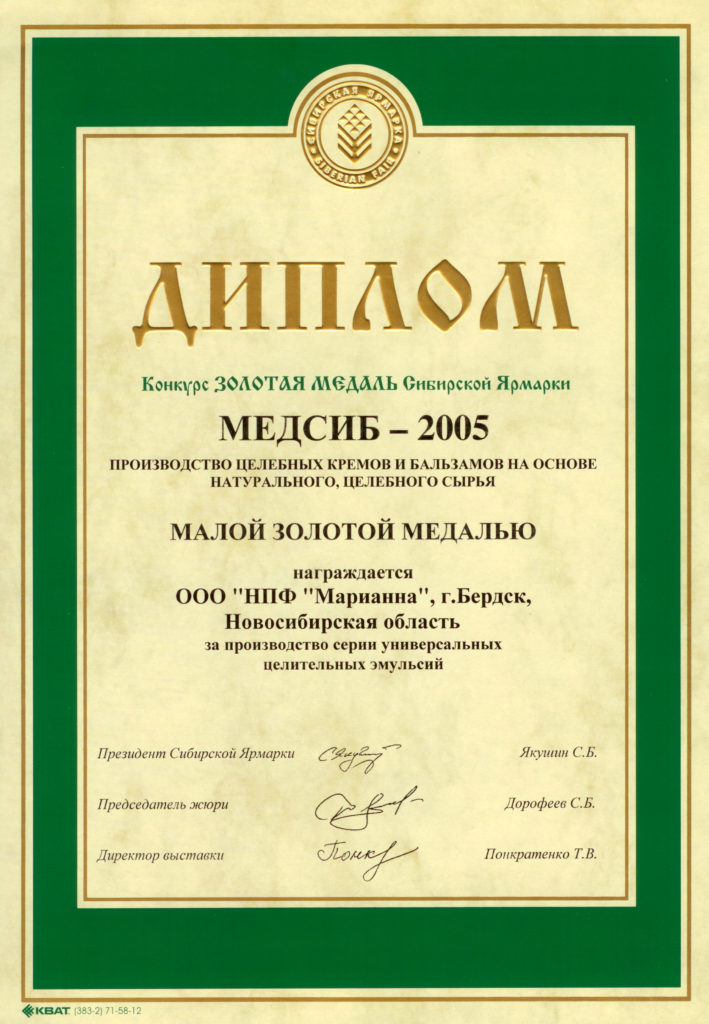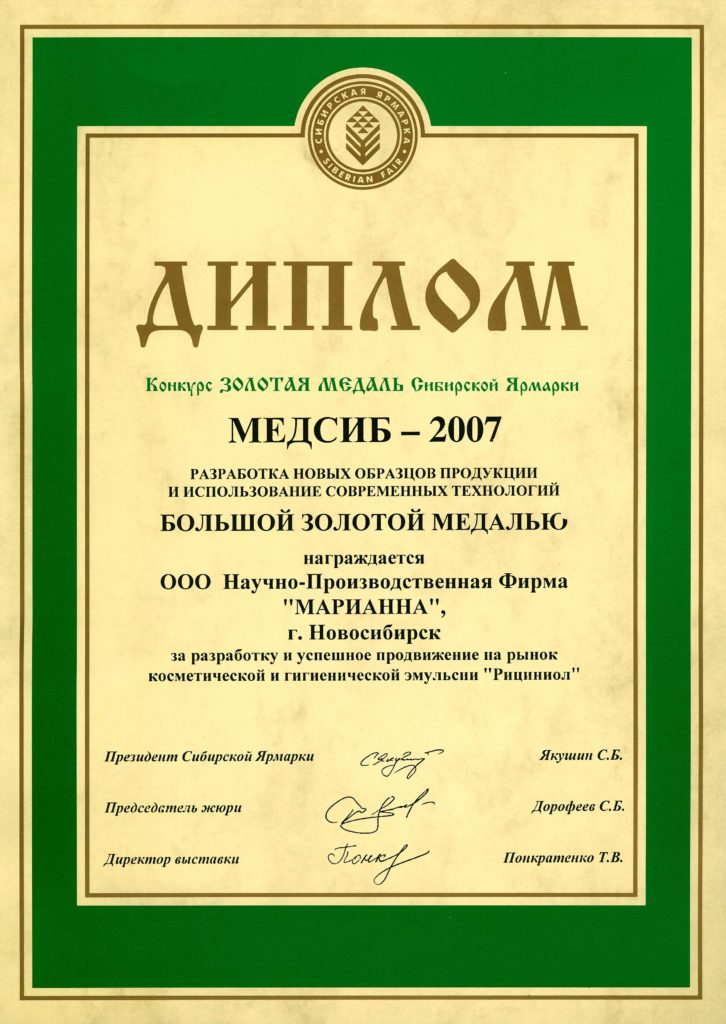General information about Riciniol.
And yet castor oil is far from Riciniol. Riciniol isn’t “raw” oil, it’s an emulsion. Its formula was patented in 1996. Riciniol’s effects are exceptionally multifaceted, as evidenced by the gold medals of the Siberian Fair received in 2004, 2005 and 2007. The creator of Riciniol emulsion is a teacher at the Department of Molecular Biology, NSU Olga Martsinkevich.
of Siberian Fair.
For multi-functionality and ease of use a series of universal Riciniol emulsions.
of the Siberian Fair.
For the production of universal healing emulsions.
of the Siberian Fair.
For the development and successful promotion of cosmetic products on the market. and a hygienic Riciniol emulsion.
Riciniol – in contrast to castor oil, often perceived as a banal laxative – is a classic external remedy.
It does not compete with dietary supplements. It quickly penetrates the matrix structures and acting on its own, Riciniol enhances not only the effects of dietary supplements, but also the effects of medicines.
Today the following properties of Riciniol have been proven (in Russia):
- analgesic,
- styptic,
- antiseptic,
- anti-inflammatory,
- wound healing,
- cosmetic,
- as well as the ability to extract foreign bodies that are shallowly under the skin.
In addition, it is an effective means of rehabilitation of the skin after burns.
Other effects of Riciniol have been observed and are now being studied and proven. All Riciniol formulas are based on Riciniol Classic bio-emulsion. It is a slightly opalescent thick liquid with a specific smell and taste.
It was developed for:
- skin, nail, hair and mucous membranes care;
- prevention of infectious diseases;
- first aid for injuries, burns, bleeding;
Structure
Riciniol Classic is the base for all of our formulas with exception of Riciniol Baby.
Ingredients of Riciniol Classic:
- castor oil
- purified water
- vitamin C
- vitamin E
- lecithin
Castor oil itself is made up of fatty carboxylic acids which are indispensable “building material” for cell structure and repair.
Composition of castor oil:
- Ricinoleic acid – 85.5% of bio-emulsion
- Oleic fatty acid
- Linoleic fatty acid
- Stearic fatty acid
- Oxystearic fatty acid
How riciniol works
Secret One: Formula
Riciniol is a unique complex of various fatty carboxylic acid types. It includes even those that are not synthesized by the body on its own (irreplaceable).
Why are fatty acids so important?
They perform many functions in the body, for example, they are the precursors of the biosynthesis of hormones, vitamins and other biologically active compounds. But the main thing is that they are what our cell membranes are built from.
When the integrity of the membrane is compromised, cells and tissues become vulnerable to foreign invasion. But in most cases, the damage is quickly repaired on its own, if you ensure the influx of high-quality “building material”, for example, fatty carboxylic acids found in the Riciniol bio-emulsion.
The main feature of Riciniol is a high percentage of monounsaturated fatty acids (MFAs). The main active component of the emulsion is monounsaturated oxygen-containing ricinoleic acid. Its unusual properties explain many of the health effects of Riciniol, which will be discussed later in the guide.
Secret Two: structure
We have already said that due to the special structure of the bio-emulsion has properties that are different from the properties of their constituents. Riciniol is proof of this. All biologically active substances of castor oil in the bio-emulsion have become highly available. Unlike its ancestor (castor oil), the emulsion penetrates the tissues more easily and is better absorbed by them. Thus, using a natural remedy, you get an unexpectedly quick result.


